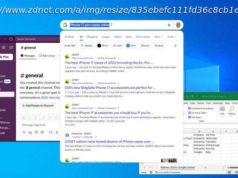HTC has officially announced its new flagship phone, just two months after its last flagship went on sale. The U 11’s key selling point is the ability to ‘squeeze’ it to activate apps and features.
In mid-January, HTC unveiled a new flagship phone, the U Ultra, featuring a Snapdragon 821 processor, 4GB RAM, 64GB of storage, and dual displays, similar to the LG V10 and V20. A day later, the company said that it was significantly reducing the size of its product range in 2017, and ruled out launching a ‘HTC 11’ to succeed the 10.
Less than a fortnight after that, HTC revealed that «another flagship» was on the way. Its U Ultra only went on sale two months ago, priced at $749 — but today, the company has already unveiled its next flagship handset, the U 11.
Yesterday was HTC’s 20th anniversary, and its mobile chief said today that the launch of the U 11 is a testament to two decades of innovation, and the firm’s «pioneering experiences», including HTC Sense, metal unibody devices, UltraPixel cameras, and BoomSound speakers. HTC mobile chief Chialin Chang spent the opening minutes of today’s launch event looking back on the company’s mobile achievements, before formally announcing the new handset.
As the company confirmed in a teaser last month, the new handset’s key differentiating feature is the ability to ‘squeeze’ the device as a new method of interacting with it. Chang said that squeezing is a ‘natural’ action, likening it to a baby squeezing its mother’s hand for a feeling of safety.
HTC said the U 11 offers «voice with squeeze combined», with support for Google Assistant, as well as Amazon Alexa — and in China, it will also support Baidu DuerOS. HTC added that, thanks to the Snapdragon 835 processor, the device will also support multiple ‘wake words’ to activate different assistants with voice prompts, such as ‘Ok Google’.
Alexa Wake Word support isn’t yet available for the U 11, but will launch in the US, UK and Germany within 30 days of the handset’s availability. HTC also said that its Sense Companion assistant is gaining support for new features, including weather forecasts, restaurant recommendations, and more. It claims that the U 11 offers the «most comprehensive suite of personal assistants» of any smartphone.
The company also touted the performance of the new handset’s camera; Chang said that HTC had «just been informed» that the U 11 has «the only highest ranked phone camera ever», with a DxOMark of 90.
HTC promises that the U 11’s camera has «best-in-class HDR», and «best-in-class autofocus», along with the «most stable smartphone video», including five-axis optical (OIS) and electronic image stablization (EIS) for video capture. Videos can be recorded at 4K resolution, with high-res audio, and 360-degree sound recording.
HTC said it’s added «audio focus» to the rear camera — «as you zoom in on a subject, you get more focused video» from whatever you’re focusing on, HTC explained.
The U 11 has a 16-megapixel selfie cam with EIS, but not OIS; a wide-angle lens; and «an UltraPixel-style experience».
Chang criticized media reviewers for commenting on HTC’s decision to ditch the dedicated 3.5mm headphone jack in its recent high-end handsets «without even trying to understand» its motivations, and its BoomSound innovations. HTC insists that it delivers a superior audio experience, and the U 11 builds on this with BoomSound Hi-Fi Edition speakers, and USonic Hi-Res audio earbuds which connect via the phone’s USB Type-C port, offering active noise cancellation.
The U 11 offers IP67 dust- and water-resistance too — and while the touchscreen won’t work underwater, you will be able to perform some tasks using the squeeze interactions when the phone is wet (although HTC does not recommend using the device while fully submerged) .
The device features eight super-thin ‘strain gauges’ to detect the location of each squeeze along the sides of the handset. The handset will react to two types of squeeze input — a ‘short squeeze’, and a longer ‘squeeze-and-hold’ — each of which can be programmed to different tasks or apps through the phone’s Edge Sense software.
The U 11 has a similar design to the U Ultra, following the company’s ‘Liquid Surface’ industrial design language, and HTC spent a great deal of time talking about its use of glass in the new device.
«Glass is a difficult material to work with, » HTC’s Nigel Newby-House said today. «We had to redesign our processes to shift glass from art to science.» HTC developed a 20-step ‘3D forming’ process to shape the Gorilla Glass used in the handset’s construction, and to bind it to the device’s aluminum chassis.
The U 11 will be offered in five colors: Amazing Silver, Sapphire Blue, Brilliant Black, Ice White, and Solar Red.
The U11’s key specs include:
The new phone will be available next week «in some regions», with wider availability in early June. The device is priced at $649 in the United States, £649 in the UK, and €749 in Europe. It will come with the USonic earbuds, a clear case, and a USB-C to 3.5mm adapter. Pricing for the U 11 model with 6GB of RAM and 128GB of storage has not yet been revealed.
In the US, it will be sold unlocked on Amazon and via HTC.com. Sprint is the exclusive carrier partner for the U 11 in the US, and will be offering the device for $29 a month on a 24-month plan (a total of $696) . Those who want to use the handset on AT&T, Verizon, T-Mobile or other carriers will have to purchase the unlocked model.
Домой
United States
USA — software HTC unveils 'squeezy' water-resistant U 11 flagship with Snapdragon 835, priced at...






